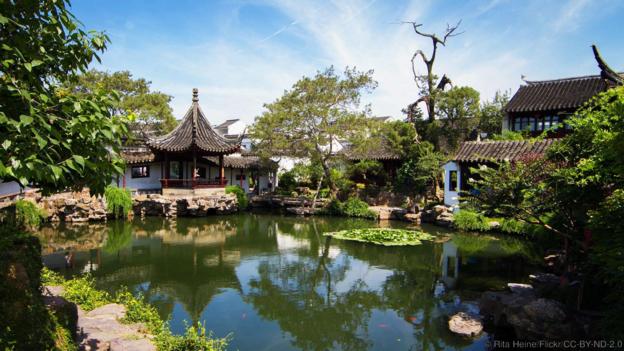
Life in one of the world’s most populous cities can be exhausting, which is why Shanghai residents are always looking for ways to escape the skyscrapers and traffic.
A favourite option lies just 100km to the east of the Chinese megacity – and only 30 minutes away by high-speed rail: the historic city of Suzhou.
Founded in 514 BC by King Helü of the Kingdom of Wu, Suzhou is one of the Yangtze Delta’s oldest and most prosperous cities. Its position between the Yangtze River in the north and Taihu Lake to the west meant that the city always had an abundant water supply, which fed the canals and classical gardens that Suzhou is world famous for.
The tranquil Master of the Nets Garden is a popular attraction (Credit: Rita Heine/Flickr/CC-BY-ND-2.0)
The first gardens were built in the 6th Century BC, but at the city’s heyday (roughly from 1500 to 1700), Suzhou had more than 800 of these tranquil spots, designed by scholars to replicate the natural environment on a smaller scale. Today there are 60 left to explore, nine of which are recognised as Unesco World Heritage sites.
My first stop was the Humble Administrator’s Garden–Suzhou’s largest – located north of the historical quarter. The secluded 52,000sqm park was commissioned between 1510 and 1516 by tired political envoy and poet Wang Xiangcheng, who wanted a place to spend his retirement in peace.
From the tall entrance gates, a labyrinth of cobblestone pathways led to small pavilions scattered throughout the garden on low, rocky hills; their curved roofs providing shade for the visitors resting on wooden benches below. In the garden’s centre were a number of ponds, interconnected via narrow streams that flowed underneath charming bridges, replete with darting orange-and-silver fish.
There must have been at least 100 admirers trying to catch the lush landscape on paper. Art students with sketchbooks and easels sat on the pavilion steps, or on large, smooth rocks by the main pond, which was barely visible under gigantic lotus leaves. It was a beautiful – though crowded – sight.
I made my way next door, to the free Suzhou Garden Museum. Inside the low Ming-style building were landscape designs made by artists hired by Suzhou’ intellectual elite during the Ming (1368-1644) and Qing (1644-1912) dynasties. Over hundreds of years, a large elite class had formed here due to Suzhou’s prosperity from trade and manufacturing, making the city synonymous with high culture and elegance.
The narrow canals remind visitors of a time when Suzhou was less populous (Credit: Russ Bowling/Flickr/CC-BY-2.0)
Back then it was believed that the unpredictable beauty of nature allowed intellectuals to think properly. This meant that having a garden was essential – and so a green space became part of every Suzhou household. While the elite competed over their elaborate garden designs, even the poorest city dweller would have planted some shrubs in his courtyard.
Chinese classical gardens are significantly different from gardens in the Western world, however. As the Chinese believe, Europeans want to conquer nature, keeping plants and bushes behind their appointed boundaries. Chinese garden designers, on the other hand, seek to find the ultimate harmony between man and the natural world.
This means that although the bushes, plants, trees and flowers might seem to grow wildly, they are in fact meticulously planned around pavilions, ponds and bridges in order to reflect the Chinese appreciation of balance and harmony. Rocks play an especially important role in this philosophy, symbolising the bridge between humans and nature. Although stones might look scattered, their placement between the manmade pathways and the garden’s natural elements – bushes, trees and waterfalls – is highly deliberate.
To see the city in its heyday, visit Suzhou’s small historic quarter. White two-storey Ming-style houses look over tranquil canals bordered by graceful willows, and playful stone bridges and steps descend from the quays. The contrast with Shanghai’s shiny skyscrapers and intense traffic couldn’t be clearer.
At times, the main street Pingjiang lu can feel like a tourist hotspot, with vendors selling everything from Nutella waffles to brightly-coloured Chinese fans. But when I visited, there was nothing glossy about the traditional wooden boats that drifted through the canals, steered by scruffy old men who didn’t seem at all eager to take my money.
I decided to stop for a light lunch of juicy xiaolongbao at Shi Jian Huo Jian, an unpretentious restaurant on the crossing of Pingjiang lu and Baita lu. This delicious dish of small, steamed, meat-filled soup dumplings is typical to the Jiangnan area, where both Shanghai and Suzhou are situated.
My final stop for the day was Jinji Lake, 7km to the east and one of the many lakes in the area that helps bring calm and cool air to the city.
While the lanes were narrow in the historic quarter, the landscape was here vast and open. As I followed a long, winding boulevard along the water, the only sounds were my footsteps on the wooden boardwalk and faint conversations blown from over the water. The few visitors I could see were riding the tandems and tricycles for hire on the west side of the lake. On the opposite side, the outline of a Ferris wheel loomed through the fog next to a series of high rises. Boats drifted to the manmade isles in the lake’s centre. As I strolled a little further, I heard some older ladies chatting in a thick Suzhou accent.
I felt myself relax and unwind. If I’d had more time, I would have gone camping at Lake Taihu in Suzhou’s southwest or visited the famous old town of Tongli in the city’s south. For now, though, I stopped and listened to the birds and the sound of the boats splashing on the water, enjoying the solitude and peace before returning to the hustle and bustle of Shanghai.












